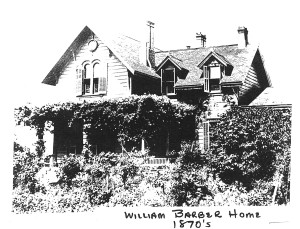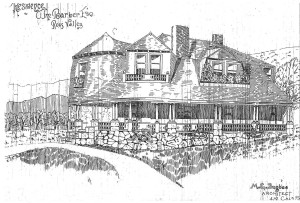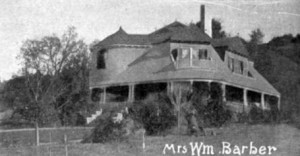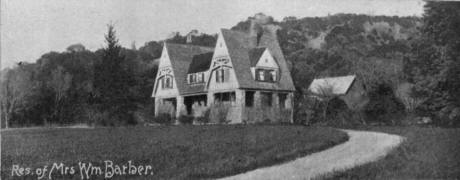
William & Elizabeth Barber
William Barber was born in June 1819 in London, England, the second son of Henry Barber, a well-known physician in London. He came to the United States when he was eighteen and was naturalized in New York in June 1843. He studied law in New York and was admitted to the bar in that state. He came to California in 1851-52 and established one of the first law practices in San Francisco. He was listed with offices on Clay Street in the 1852 San Francisco Directory. In 1863, Barber’s offices were in the Wells Building at the corner of Clay and Montgomery and his residence was 321 Geary. He joined in partnership with John T. Doyle, and the firm of Barber and Doyle became well-known in San Francisco, specializing in admiralty and insurance law. William Barber was at one time the district attorney of San Francisco.
In 1862, William Barber visited the East and met and married Elizabeth Bartlett Jackson. Elizabeth was born April 2, 1837 in Boston, Massachusetts to Charles Thomas Jackson and Susan Bridge. She was a descendant of Abraham Jackson, one of the early colonists of Plymouth and of the Puritan divine, John Cotton. Her father was a Harvard-trained doctor and Boston scientist whose laboratory for research in analytical chemistry was the first of its kind in the United States. He was one of the discoverers of ether and is credited with numerous other notable scientific achievements. Elizabeth’s aunt, Lydian Jackson, married Ralph Waldo Emerson.
The Barbers had two daughters: Alice Jackson Barber, born April 21, 1867, and Mary (Mamie) Dunkin Barber, born March 20, 1869. Two sons, William and Henry, died in infancy.

Original Barber Home
Shortly after purchasing their initial 71 acres in Ross Valley in 1866, the Barbers built a home on a portion of the property and made it their primary residence. The site is now in the town of Ross (1 Garden Way in Winship Park). In the 1870 U.S. Census, William Barber is listed with Elizabeth, Alice, age 3, and Mary age 1. In the household were also two domestic servants and a laborer. The real estate was valued at $80,000 and their personal property at $10,000.
Ross Valley was scarcely populated in the 1870s, and the girls attended school in the little school house which Minthorne Tompkins built on his property in 1874. Miss Emma Burhans taught the Tompkins children as a well as Alice and Mamie.
Ralph Waldo Emerson, while traveling in California in April 1871, visited his niece Elizabeth Barber and wrote to his wife describing a day he spent with the Barbers:
“But I have not said what was on my mind when I began, that we three went to San Rafael Tuesday, to Mr. Barber’s, and spent the day and night there. It is a charming home, one of the beauties of this beautiful land. All shone with hospitality and health. They showed us every kindness. The house is new and perfectly well built and appointed. His place has seventy-one acres of plain and wood and mountain, and he is a man of taste and knows and uses its values. Three or four wild deer still feed on his land, and now and then come near the house. The trees of his wood were almost all new to us—live-oak, madrona, redwood, and other pines than ours; and our garden flowers wild in all the fields.” (James Elliot Cabot, A Memoir of Ralph Waldo Emerson, 1887).
In an article in the Daily Alta California, June 21,1885 the house is described as follows:
“Among city people who took up their residence in the valley was William Barber, a San Francisco lawyer of the firm Doyle & Barber, a gentleman of English birth and quiet and scholarly manner whose home is situated at the lower entrance to the valley near the narrow gauge railroad. The house is an old-fashioned building with many gables, crossed by a veranda in front, whose entire length is overhung with vines, which run up the light pillars and trail over the balustrade above. The place is not built for show, and indeed is artfully withdrawn from public observation, approached by a long road winding through a grain field, and sheltered by gentle rises of ground on every side. It is an idyllic residence for a poet and a scholar and the grounds at the rear are elaborately and artistically laid out, with tangled wood paths, rustic bridges and solitary retreats, which suggest the home of N. P. Willis, Idlewild.”
Furnished homes in Ross Valley were in great demand as summer rentals by wealthy San Franciscans and the Barbers frequently rented their home while they were traveling to Santa Barbara, east to visit Elizabeth’s relatives, or to Europe. In 1892, they built another home on their property to rent during the summer months. The architect was Maxwell G. Bugbee, and the house exists today at 73 Winship. The house was illustrated in the April 1892 edition of California Architect and Building News noting that a “deep veranda extends along three sides, and halls and rooms are spacious and arranged for comfort and convenience.”

Architect’s drawing of the 1892 summer rental (73 Winship)

73 Winship (known as Gray House), c. 1901
On July 9, 1896, the Barber’s original 30 year old home burned to the ground. The fire started in the kitchen chimney, and fortunately a large group of volunteers were able to save furniture, silver and an extensive library of rare books from the downstairs rooms before the fire destroyed the home. The barn was also saved. The Barber’s camped out for the summer while a new home was built on the original site (1 Garden Way). The architect was again Maxwell G. Bugbee. Viewed from the front today, the house looks very much as it did in early photographs with its steeply-pitched roofs.

c. 1901
In 1900, the Barber household included William, Elizabeth, Alice, and Mary as well as Helen Flaherty, a 28 year old Irish housekeeper, Agnes Morrison, a 29 year old nurse, Ah Ling, a 24 year old Chinese cook, and John Harlan, a 32 year old Irish coachman.
William Barber died on April 7, 1901. Even though he continued to be listed as an attorney in the San Francisco Directory up until 1899, he spent his last years in quiet retirement in Ross Valley, perhaps fishing for steelhead and salmon in the San Anselmo creek which ran through his property. He became interested in his father-in-law’s discovery of ether and the controversy that ensued and wrote an article “Dr. Jackson’s Discovery of Ether” which appeared in the National Magazine in October 1896. Elizabeth Barber died from complications of heart and lung disease on December 27th, 1908 at the age of 73.
On October 30, 1910, at the age of 43, Alice J. Barber married Edwin Floyd Jones, an auto dealer. The wedding took place at the “Barber Place” which was at this time at 73 Winship. Mary was maid of honor. Sadly the marriage was to last less than three years, as Edwin Floyd Jones died of a heart attack on August 13, 1913 while eating a meal with friends at a restaurant in San Rafael. Alice never remarried. She lived in a home at Rocky Point on land that her mother had deeded to her in 1905. For many years her gardener and driver, James Reynolds, lived on the property. Alice died on April 22, 1942, the day after her 75th birthday.
Mary D. Barber never married. She built a home at 78 Alta Vista in about 1908 on land deeded to her by her mother. The house was described as a beautifully designed craftsman house with a side gable and an exterior faced with vertical tongue and groove boards. The original entrance was at the back with a curving garden walk leading to second story entry stairs.
Mary Barber was a talented painter and writer and seems to have been of adventurous spirit as well. In an article, “Salvage”, published in the Overland Monthly in December 1909, she wrote about the salvage of the steamer R. D. Inman which ran aground near Duxbury Reef in Bolinas. Mary also had a home in Bolinas (she acquired the land in 1907) and from there she watched the progress of the salvage effort. She and a female companion were the first women to board the ship and on one visit they donned a 140 lb. diving suit. In 1918 Mary published a small booklet, “Winter Butterflies in Bolinas.”
In January 1929, at age 59, Mary suffered a nervous breakdown and, while undergoing treatment at Stanford Hospital, committed suicide. The Marin Journal reported that she fashioned a noose out of clothing and hung herself from the door hinge. A very sad ending! She bequeathed her home to Malcolm S. Edgar, the doctor who attended her during her three years’ illness, and another $40,000 (described as ¼ of her estate) to Stanford Hospital for benevolent medical and surgical work. She left her Bolinas property to Mary D. (Stearns) Burke, the niece of Adeline E. Kent and a friend since childhood. Donald E. Perry was the executor of her estate.

